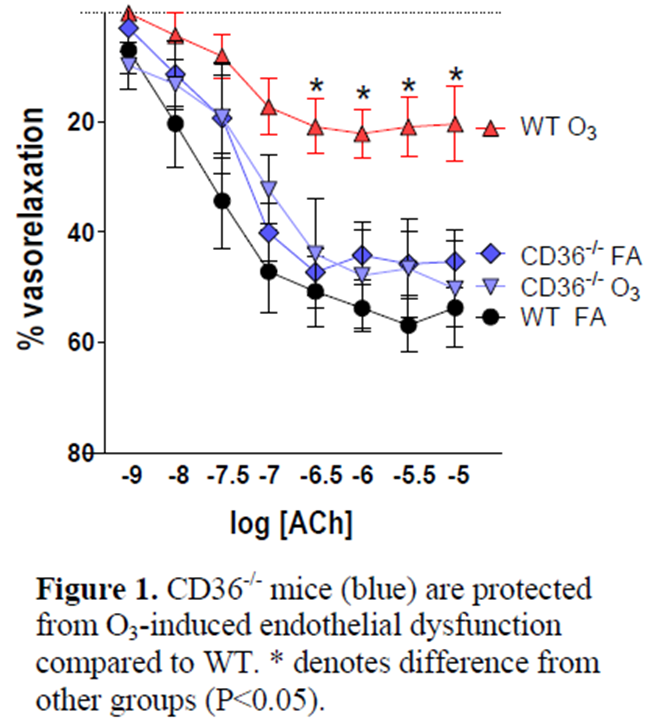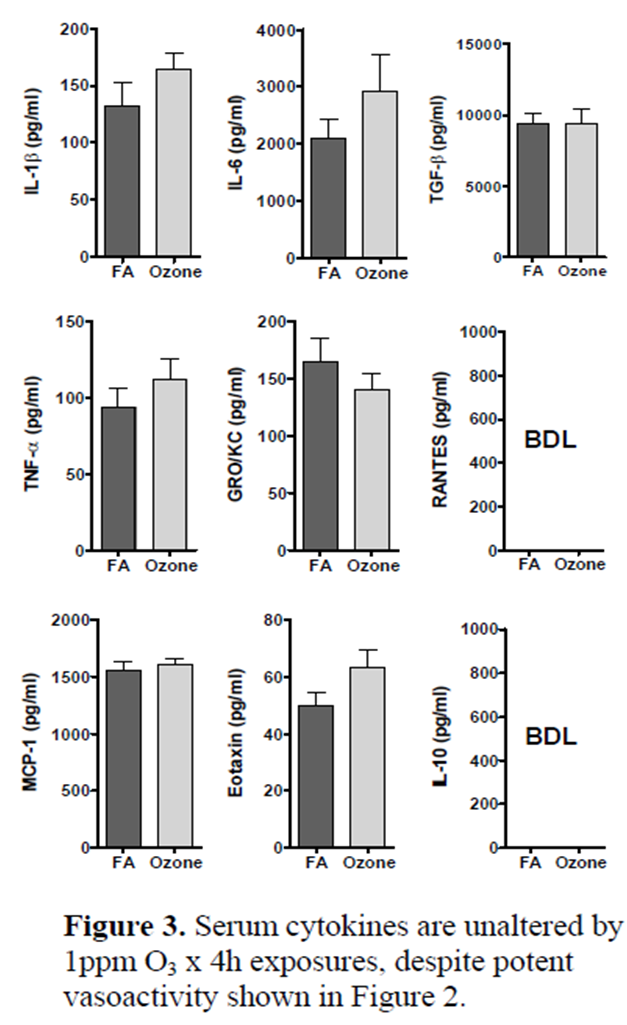Grantee Research Project Results
2013 Progress Report: Cardiovascular Consequences of Immune Modification by Traffic-Related Emissions
EPA Grant Number: R834796C003Subproject: this is subproject number 003 , established and managed by the Center Director under grant R834796
(EPA does not fund or establish subprojects; EPA awards and manages the overall grant for this center).
Center: University of Washington Center for Clean Air Research
Center Director: Vedal, Sverre
Title: Cardiovascular Consequences of Immune Modification by Traffic-Related Emissions
Investigators: Campen, Matthew J. , McDonald, Jacob D. , Lund, Amie K. , Rosenfeld, Michael
Institution: University of New Mexico , University of Washington , Lovelace Biomedical & Environmental Research Institute
Current Institution: Lovelace Biomedical & Environmental Research Institute , University of New Mexico , University of Washington
EPA Project Officer: Callan, Richard
Project Period: December 1, 2010 through November 30, 2015 (Extended to November 30, 2017)
Project Period Covered by this Report: December 1, 2012 through November 30,2013
RFA: Clean Air Research Centers (2009) RFA Text | Recipients Lists
Research Category: Human Health , Air
Objective:
Traffic-related emissions are associated with the incidence and progression of acute and chronic cardiovascular sequelae in human population studies. Such phenomena of near-roadway health effects have yet to be characterized toxicologically.
Because of overlapping issues related to noise, socioeconomic status, ethnicity, etc., there is a need to better understand the biological plausibility that fresh mixtures of vehicular emissions have a more potent than expected impact on human health. We hypothesize that the complex mixtures produced by traffic are inherently more toxic due to the combined presence of both particulates and volatile organic emissions. Furthermore, we hypothesize that emissions-induced oxidation of certain endogenous phospholipids, presumably from the pulmonary surfactant, can stimulate the activity of immune cells through such receptors and in turn promote the invasion of existing vascular lesions.
Approach: This project will use complex roadway mixtures as generated and characterized in the laboratory. In Aim 1, we will ascertain (1) the potentiating effects of physical and photochemical aging on fresh emissions and (2) interactions of vehicular emissions with pertinent co-pollutants (ozone, road dust), both in terms of driving systemic vascular oxidative stress. In Aim 2, we will examine the effects of the emissions-induced oxidative modifications to endogenous phospholipids, in terms of activating immune-modulating receptors such as LOX-1, CD-36, TLR-2, and TLR-4. This Aim will utilize transgenic models to examine the roles of these receptors, as well as characterize the lipidomic alterations in various tissues. Lastly, in Aim 3, we will further explore the role of specific immune cell populations as participants in the innate and adaptive responses to emissions-induced phospholipid modifications. In this Aim, we will utilize mouse models of immunodeficiency, including SCID and B-Cell deficient models. Additionally, we will pursue bone-marrow transplants from mice lacking those receptors described in Aim 2 to mechanistically establish the involvement of the oxidatively modified phospholipids.
Owing to suggestions from the advisory committee, we have focused on the nature and bioactivity of circulating factors induced by pollutant exposures, as these appear to be ligands that interact with the scavenger receptors of interest in Aims 2 and 3. This has been an area of significant progress for the past year.
Progress Summary:



Future Activities:
- Aim 1: Compare potency of mixed emissions and photochemically transformed emissions in terms of serum inflammatory potential.
- Aim 2: Explore roles of TLR4 and LOX-1 with O3 responses, as per CD36. Consider all KO models with MVE exposures.
- Aim 3: Develop assays to measure monocyte response to serum factors, as a parallel to the endothelial assays.
Expected Results: Findings will (1) indicate the most potent combinations of urban roadway and background co-pollutants in terms of vascular toxicity and (2) detail the role of the immune system in mechanistically driving the systemic effects of inhaled pollutants.
Journal Articles on this Report : 4 Displayed | Download in RIS Format
| Other subproject views: | All 26 publications | 16 publications in selected types | All 16 journal articles |
|---|---|---|---|
| Other center views: | All 197 publications | 94 publications in selected types | All 93 journal articles |
| Type | Citation | ||
|---|---|---|---|
|
|
Campen MJ, Lund A, Rosenfeld M. Mechanisms linking traffic-related air pollution and atherosclerosis. Current Opinion in Pulmonary Medicine 2012;18(2):155-160. |
R834796 (2012) R834796 (2013) R834796 (2015) R834796 (Final) R834796C003 (2012) R834796C003 (2013) R834796C003 (Final) R833990 (2010) R833990 (2011) |
Exit |
|
|
Lund AK, Doyle-Eisele M, Lin Y-H, Arashiro M, Surratt JD, Holmes T, Schilling KA, Seinfeld JH, Rohr AC, Knipping EM, McDonald, JD. The effects of α-pinene versus toluene-derived secondary organic aerosol exposure on the expression of markers associated with vascular disease. Inhalation Toxicology 2013;25(6):309-324. |
R834796 (2013) R834796 (2014) R834796 (2015) R834796 (Final) R834796C002 (2015) R834796C002 (Final) R834796C003 (2013) R833990 (2011) |
Exit Exit |
|
|
Robertson S, Colombo ES, Lucas SN, Hall PR, Febbraio M, Paffett ML, Campen MJ. CD36 mediates endothelial dysfunction downstream of circulating factors induced by O3 exposure. Toxicological Sciences 2013;134(2):304-311. |
R834796 (2013) R834796 (2014) R834796 (2015) R834796 (Final) R834796C003 (2013) R834796C003 (2016) R834796C003 (Final) R833990 (2011) R833990 (Final) |
Exit Exit Exit |
|
|
Yin F, Lawal A, Ricks J, Fox JR, Larson T, Navab M, Fogelman AM, Rosenfeld ME, Araujo JA. Diesel exhaust induces systemic lipid peroxidation and development of dysfunctional pro-oxidant and pro-inflammatory high-density lipoprotein. Arteriosclerosis, Thrombosis, and Vascular Biology 2013;33(6):1153-1161. |
R834796 (2013) R834796 (2014) R834796 (2015) R834796 (Final) R834796C003 (2013) R834796C003 (2016) R834796C003 (Final) |
Exit Exit Exit |
Supplemental Keywords:
Coronary artery disease, oxidized phospholipids, atherosclerosis, particulate matter, volatile organic compounds, carbon monoxide, ozone, Health, Air, Scientific Discipline, ENVIRONMENTAL MANAGEMENT, Health Risk Assessment, Risk Assessments, Air Quality, mobile sources, Biochemistry, air toxics, Environmental Monitoring, Risk Assessment, aerosol particles, vehicle emissions, bioavailability, atmospheric chemistry, motor vehicle emissions, particulate matter, motor vehicle exhaust, ambient particle health effects, cardiotoxicity, air quality models, air pollutants, atmospheric aerosols, atmospheric particulate matter, vascular dysfunction, ambient air quality, air pollution, cardiovascular disease, exposure assessment, airway diseaseRelevant Websites:
Progress and Final Reports:
Original AbstractMain Center Abstract and Reports:
R834796 University of Washington Center for Clean Air Research Subprojects under this Center: (EPA does not fund or establish subprojects; EPA awards and manages the overall grant for this center).
R834796C001 Exposure Mapping – Characterization of Gases and Particles for ExposureAssessment in Health Effects and Laboratory Studies
R834796C002 Simulated Roadway Exposure Atmospheres for Laboratory Animal and Human Studies
R834796C003 Cardiovascular Consequences of Immune Modification by Traffic-Related Emissions
R834796C004 Vascular Response to Traffic-Derived Inhalation in Humans
R834796C005 Effects of Long-Term Exposure to Traffic-Derived Particles and Gases on Subclinical Measures of Cardiovascular Disease in a Multi-Ethnic Cohort
The perspectives, information and conclusions conveyed in research project abstracts, progress reports, final reports, journal abstracts and journal publications convey the viewpoints of the principal investigator and may not represent the views and policies of ORD and EPA. Conclusions drawn by the principal investigators have not been reviewed by the Agency.
Project Research Results
- Final Report
- 2016 Progress Report
- 2015 Progress Report
- 2014
- 2012 Progress Report
- 2011 Progress Report
- Original Abstract
16 journal articles for this subproject
Main Center: R834796
197 publications for this center
93 journal articles for this center

